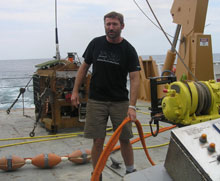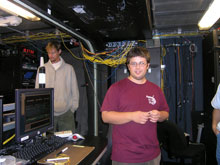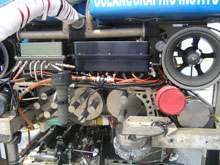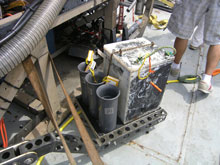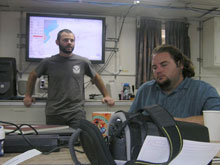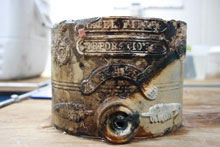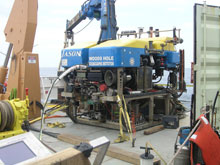
The remotely operated vehicle (ROV) Jason II rests on the deck of the NOAA ship Ronald H. Brown. Click image for larger view and image credit.
Jason expedition leader Matt Heintz, with Medea in the background. Click image for larger view and image credit.
First Flight with Jason!
September 6, 2009
Lori Johnston
Harry Roberts
Louisiana State University
Sheli Smith, PhD
PAST Foundation
Day 2 on the good ship Ron Brown: the first dive was a screaming success! The remotely operated vehicle (ROV) Jason hit the water at about 8 p.m. — and we were off to the races. At a depth of 632 meters (2,073 feet) below surface and with decent visibility, the Viosca Knoll wreck could be clearly analyzed. With archeologists, biologists, and geologists anxiously waiting their turn to do work on the wreck, we were all assigned shifts for the ROV. Some were logging the images and work being done; others changed DVDs and logged ROV times. Although Chief Scientist Erik Cordes, a biologist from Temple University, oversees the overall research mission, each scientist and graduate student has an official job during his or her watch. Each watch, or four-hour period, has a watch chief and others assigned to specific task. There are so many things to do to prepare, and then there's even more data to sort through once it's been collected.
Once Jason was launched with one chief scientist in charge, we were able to do a photomosaic of the wreck; a biological transect of critters around the wreck; core samples of the sediment; and close inspection of the corals that have inhabited the sunken vessel. When a structure such as a ship sinks, it becomes devoid of human life, but begins to be inhabited by other biological life. In fact, there is more life now on the wreck than there was when she was a ship floating gracefully on the surface. The life ranges from large fish and anemones to corals and the microscopic bacteria that are slowing breaking down the ship. A lesson in life: It does not stop, even under hundreds of meters of water, it just changes form.
Jason on Recon and Photomosaic Duty
Jason is set up with cameras, buckets, boxes, basket, and quivers, along with the compartments in the slurp machine to capture data and bring it home to the surface. We began with a reconnaissance of the wreck, flying down the outer port side of the exposed hull that sits proud of (projects from) the bottom. To our surprise, the copper sheathing looks like a patchwork quilt. The long strips of copper were narrower than expected, with lots of patches. We spent a good amount of time in the stern looking at structural remains and trying to make sense of the twisted mess.
“You can clearly see where the anchor line from the nearby oil rig cut through the hull in the stern,” Rob Church announced, pointing out from the watch chair, where he controlled the zoom on one of Jason's cameras.
Flying up the starboard hull, we noted objects and hull structure and we pointed out new views out and discussed the upcoming recovery with U.S. Minerals Management Service archaeologist Jack Irion. Once the "recon" was complete, the team got down to the business of flying the mosaic. Under the careful guidance of Jason pilots, navigators, and engineers, the ROV flew transects, 1 m (3 ft) apart, up and down the wreck, just 5 m (16 ft) above the bottom, while we took a 10-second series of mosaic still images. Today, we flew 19 lines — each 50 m (164 ft) in length — recording the hull from above for a future mosaic.
Once we had finished our mosaic, biologists Peter Etnoyer from Texas A&M University and Stephanie Lessard-Pilon from Temple University took over recording biological data and taking a series of soft core samples from around the wreck. They took samples from as close as 10 m (33 ft) away and as far as 100 m (329 ft) away for analysis of the benthic (sediment dwelling) organisms.
Archaelogists Collect a Mystery Sample
Following the photography, the archaeology team got to work, collecting samples that will help date, and possibly identify, the wreck. First, we retrieved a small piece of copper sheathing from the portside stern (left, rear) area. We chose a piece that had an original edge so that we could examine overlap and nailing pattern. The entire hull below the waterline is sheathed in thin copper sheets. The sheathing is intact back along the portside until the hull begins to rise toward the stern. In the stern quarter, the copper has eroded away, leaving exposed outer hull planking. It was exciting to see evidence of trunnels (wooden pegs) and bronze drift pins with washers. At the top of the extant hull we could measure, with the lasers affixed to Jason, the length of the exposed drift pin, coming up with a thickness for the hull just below the thick wale. At this point the hull was 14 inches thick, taking in the outer hull plank, the sided dimension of the frame, and the interior ceiling planking.
Our second recovery was on the aft starboard side of the hull. There we found a box with eight cans of some material sitting upright. Using the slurp suction hose attached to Jason, our pilot, Bob, gently cleared off the top of one of the round artifacts. It appears to be the remnant sediment of whatever was in the can (that has since disintegrated). Just to the starboard of the box sat a container, incised with a three lines around its waist. We decided to recover the piece to help determine the age of the vessel at the time of sinking. We all had wild ideas about the nature of the pot and what it was used for.
Boy, were we surprised when we pulled it out of the holding bucket on the surface. The pot wasn’t metal, but rather glazed — stoneware. On the side that faced away from the camera underwater were applied decorative, ceramic motifs and banners identifying the use of the pot and where it was made. Jack Irion and Jake Schidner, from the University of West Florida’s conservation lab, went to work: first, to protect the pot and copper sample once on the surface so that they can be stabilized later in the conservation lab, and then to unravel the mystery of the fragmented information on the pot.
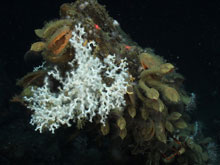
The stempost (the vertical timber in the bow) of the wreck is covered in Lophelia, stalk barnacles, Acesta clams, and anemones. Click image for larger view and image credit.
The stoneware jar water filter with laid on motifs and information led us to Jowett W.M. & Co of 75 Corporation Street in Manchester, England. Click image for larger view and image credit.
A Cholera Connection
Jack worked throughout the day, piecing together bits of information through his search on the Web until we were able to identify the pot and its function. As it turns out, scientists in the late 1850s realized that the deadly disease cholera was water-borne. Filtration systems began to be patented to help prevent the spread of the disease. The pot is the lower half of a water filter pot. W. M. Jowett & Company, located at 75 Corporation Street, in Manchester, England, manufactured the pot, according to the Kelly List of Manchester Water Filter Manufacturers for 1880.
The pot functioned as follows. First, a perforated ceramic disc was lowered into the pot, resting on a lip. Charcoal was then placed above the disc, and a second disc was lowered down on top of the charcoal. Water was poured into the top of the pot and filtered through the charcoal. A spigot at the base of the ceramic pot dispensed "cleansed" water. Still visible in the hole at the base of the pot is the remains of the spigot.
After about 12 hours in the water, it was time for Jason to return the 632 m (2,073 ft) to the surface, and for the Ron Brown to carry us all onto the next wreck. With 12 hours of collected data, the whole team is busy cataloging, downloading, transcribing, and storing the information. Some of us need some sleep. Once we’ve logged some sleep and get our plan together for next wreck, we’ll be back with more exciting news to share. See you at the 7,000 Ft wreck.




























